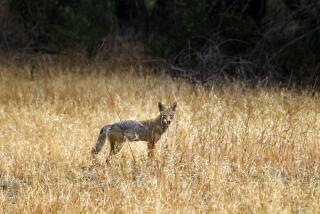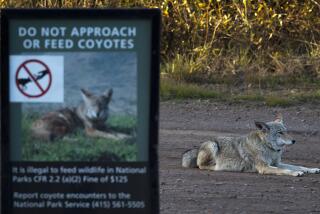Long portrayed as a villain, the coyote is gaining a flicker of respect
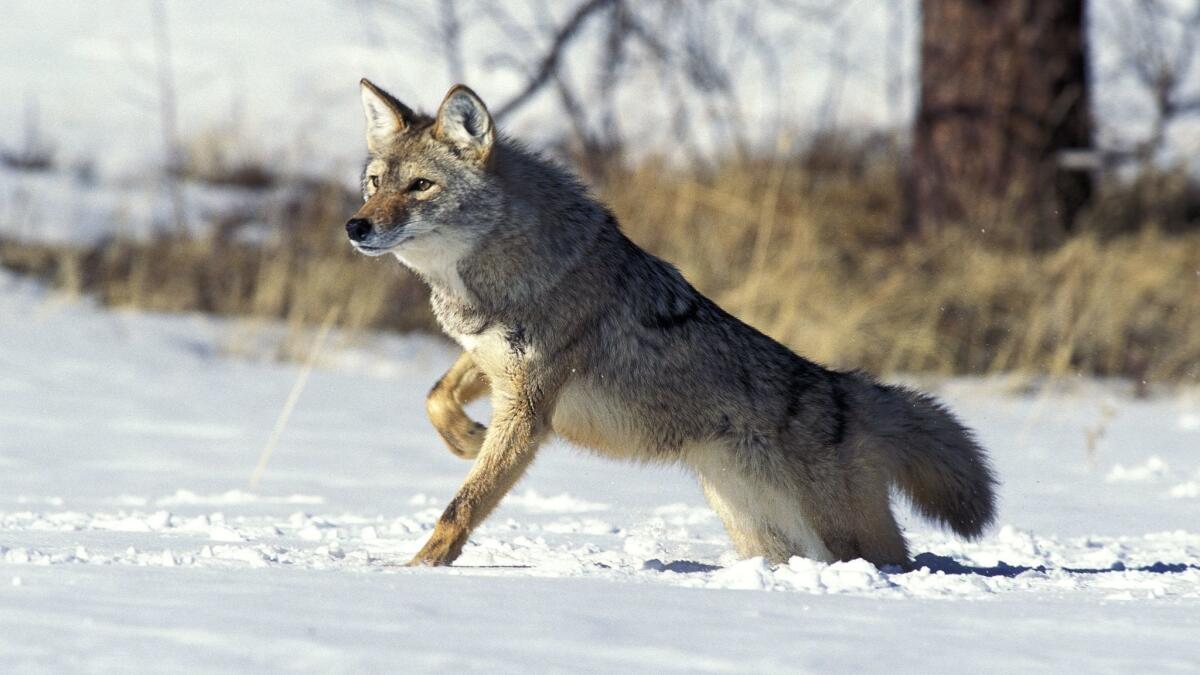
It’s a small speck of brown moving across a seemingly endless valley of snow. The valley is so silent and so frigid, it feels as if the slightest sound could crack the sky.
Franz Camenzind is unbothered by the cold. He lines up his spotting scope atop a tripod and moves it slowly, left to right. He stops, focuses. A smile creeps beneath his beard.
A trio of coyotes is trotting around the carcass of a dead elk. Ravens flit around, taking nibbles. One coyote dives in and pulls at the meat. The elk around them barely even glance over.
“Coyotes are incredible,” the biologist says. “They’re smart, cunning and incredibly adaptive. I admire them.”
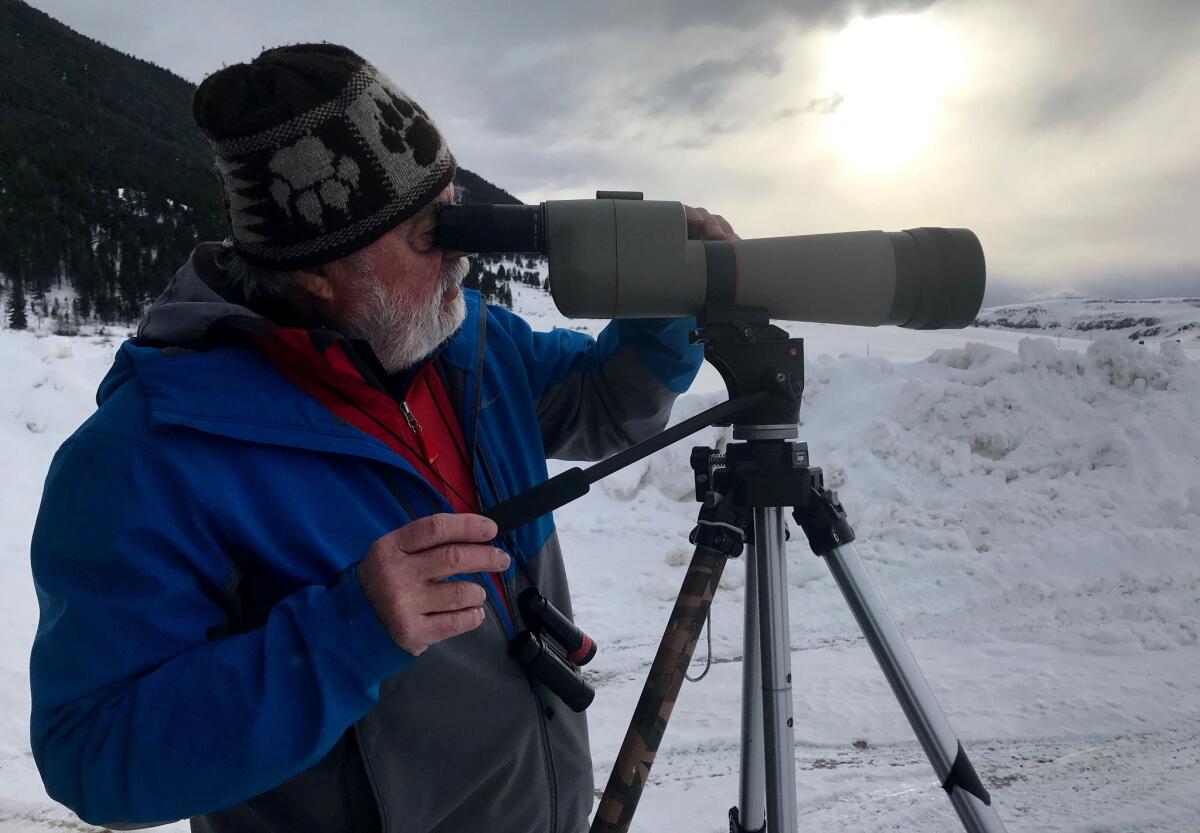
That has scarcely been the main sentiment aimed at coyotes, seen as villains in popular culture and vermin by cattle ranchers and killed in myriad ways.
But things finally may be looking up for the coyote.
New Mexico Gov. Michelle Lujan Grisham is awaiting the arrival of a bill that passed both legislative chambers this month that would eliminate coyote hunting contests — making it the third state after California and Vermont to initiate such a ban. Grisham, a Democrat who took over from Republican Gov. Susana Martinez, has until April 5 to sign it.
This year, bills to ban “coyote whacking” — killing the animals by running over them with snowmobiles — were introduced for the first time in the legislatures of Wyoming and Montana, hardly coyote-friendly refuges. However, neither bill got to a vote in the legislatures.
And national nonprofit groups mostly focused on wolf repopulation have increasingly been adding coyotes in their call to action releases.
Camilla Fox began the California-based nonprofit Project Coyote a decade ago as a way to stop killing contests and tournaments aimed at a variety of predators, including bobcats, foxes, wolves and the coyote. Camenzind, who has studied coyotes extensively, is on the group’s science advisory board.
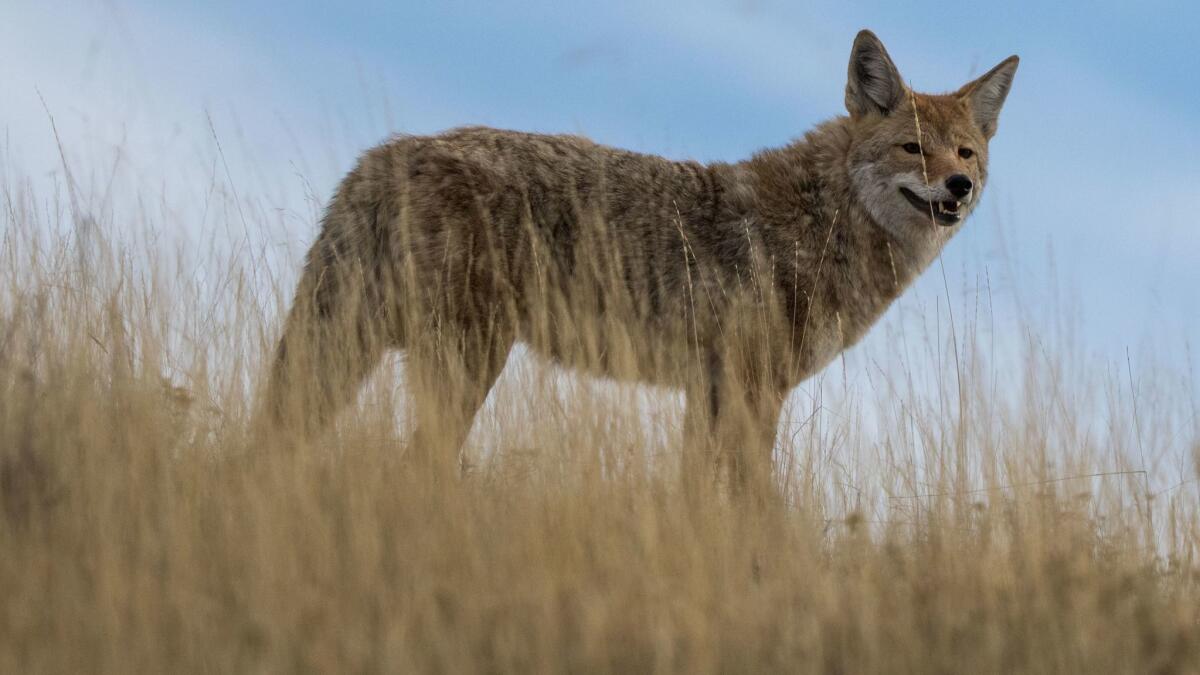
Fox said the group has only recently begun seeing small gains for the animal’s protection as images of coyote hunts and kills are spread on social media platforms. It’s been a slow slog to rehabilitate the coyote’s image, she admits.
“When we first started, we were viewed as fringe and people were asking ‘Why in the heck did you choose the coyote?’” Fox said. “We don’t have to justify that anymore. They’re so persecuted and maligned, more people are becoming aware of how badly they’re being treated.”
Mark Twain may have set the coyote’s image in stone 147 years ago when he wrote his travelogue “Roughing It.”
“He has a general slinking expression all over,” he wrote. “The coyote is a living, breathing allegory of Want. He is always hungry. He is always poor, out of luck, and friendless. The meanest creatures despise him, and even the fleas would desert him for a velocipede.”
How do coyotes thrive in urban Southern California? The answer is not for the weak-stomached »
There aren’t solid estimates on overall coyote populations in the United States, but the species has managed to thrive despite years of bounties put on their heads by the government, contests rewarding high-volume kills and human populations that have bled into wild and rural areas of America.
According to the U.S. Department of Agriculture, 68,913 coyotes were killed in 2017 — down from 76,868 in 2016. From 2010 to 2017, the USDA alone killed 592,328 coyotes.
States are also willing participants in the killing of coyotes. Utah still offers a $50 bounty for a pelt. Most states have no bag limits on the number of coyotes that can be killed. Furs can be sold for as much as $125 apiece. And coyote-killing contests are still plentiful throughout the country.
In one contest, held in southeastern Montana in January, 46 hunting teams killed 48 coyotes — the largest weighing in at 33 pounds, according to the Fallon County Times. Prizes for the contests vary, with some offering as much as $1,000 for a first-place finisher who kills the most during a hunt, which typically go for 24 hours.
It is legal to kill coyotes, with few exceptions, in virtually any way imaginable: They can be gassed, trapped, shot, burned, run over and beaten, provided they aren’t on private land, on a limited number of preserves or in national parks.
Once mostly found in Western states, coyotes now live and thrive in every state but Hawaii. They also have spread widely into Mexico and Canada. Their stubborn persistence has annoyed ranchers for decades, seeing them as a threat to their livelihood.
Mike Carrico, who runs a cattle ranch near Rawlins in southern Wyoming, takes people on coyote hunts — usually in the spring when newborn calves are at their most vulnerable.
He said a coyote’s killing of a single calf can be costly, with the value of that livestock ranging from about $800 to nearly $50,000 if it produces calves for a decade.
“That loss will make a rancher sore,” he said.
But he said he also believes in the ethical hunting of coyotes, though he conceded that definition may vary from hunter to hunter. He said for about $750, he will take hunters out on about 250 square miles of land, set up stands — where hunters will wait — and then call coyotes with sounds that bring them close before being shot.
This year, he said, coyotes haven’t been plentiful but “can still be found on every square mile of the land.” He said he has respect for the coyote who, unlike the wolf, managed to adapt and survive without help from the Endangered Species Act.
Camenzind said coyotes should engender respect as a truly native species to America. Weighing in at 35 to 40 pounds, they are smaller than wolves and can work in a pack or alone. They are resourceful and hardy.
They tend to have an alpha male in a group, and he tends to breed with a single female who will usually deliver a few pups; the other members of the group won’t breed.
The biologist said the problem with unlimited hunting of coyotes is alpha males can be killed, leading to other males in a pack who wouldn’t have otherwise bred beginning to produce litters. He said the hunting has the opposite effect of population control and that it instead leads to larger numbers of coyotes — sometimes with females breeding eight to 10 pups per litter.
Nature, he said, has its own built-in survival instinct that has helped buoy the coyotes through what predator advocacy groups believe has been a relentless killing of the animals.
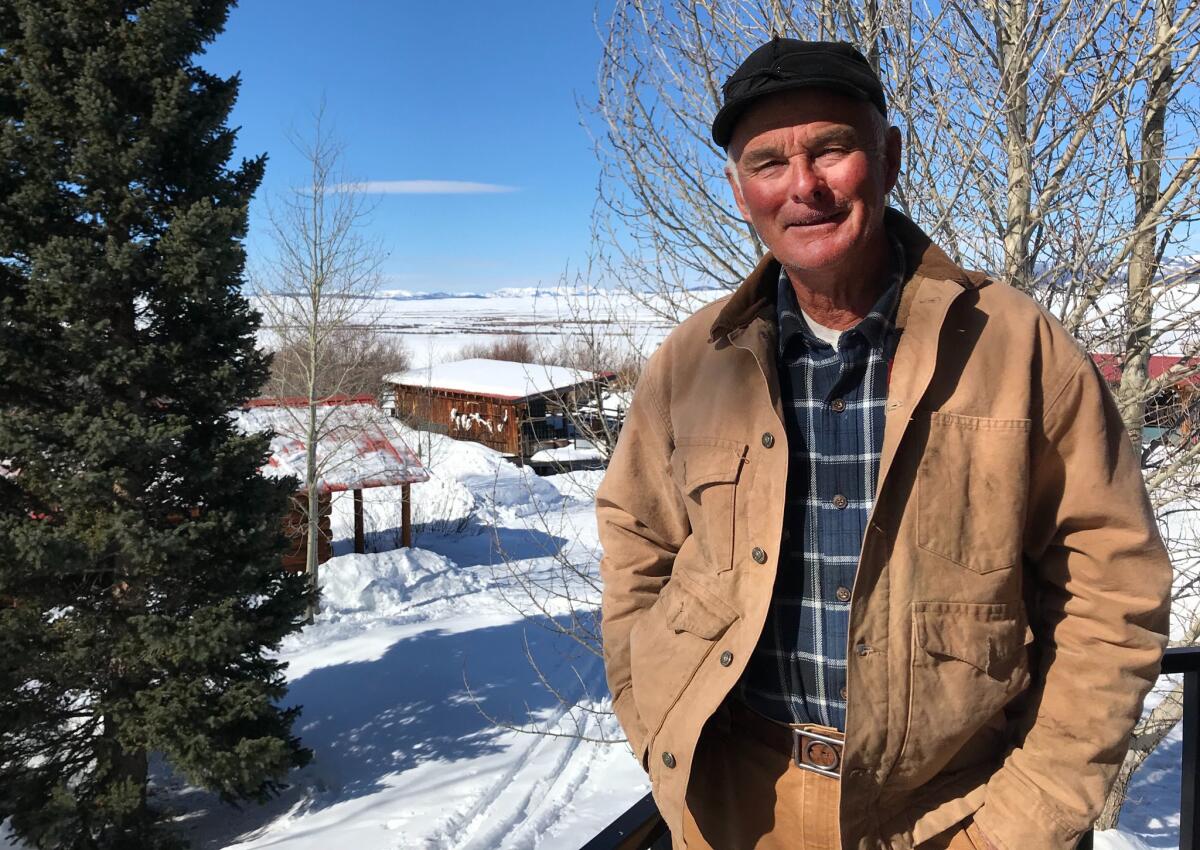
Near Pinedale — about 90 minutes from Jackson — rancher John Fandek figures he’s killed hundreds of coyotes in his lifetime. He grew up in Wyoming, starting as a ranch hand and settling to run his own cattle ranch more than five decades ago.
He’s 76 and semi-retired now, and he stopped hunting the canids several years ago, deciding instead the land was better served by allowing the coyote to do what it’s always done: keep rabbit and ground squirrel populations in check while cleaning up the mess of dead elk and deer. He sees a spot for the coyote in the ecosystem and wants to help them out.
Inside his house — with the heads of several bucks mounted on the wall — he speaks plainly about ethical hunting. He hunts only for meat and believes animals deserve dignity and a chance to avoid the crosshairs.
He walks out onto his balcony and looks over his property on the edge of U.S. Forest Service land. He spots tracks in the snow that cross his property and lead into the trees. It’s not uncommon to see the animals cross his yard, he said. His dog, Molly, doesn’t like them, but he said they’ve never bothered her, either.
He mentions the practice shown recently in videos of people running over coyotes, something he’s seen happen over several decades. Using snowmobiles to chase them to exhaustion and then running them down, he says, is barbaric.
“That’s not hunting,” he said. “They’re not working for it. When I see that, it bothers me a lot. It’s reprehensible.”
The videos have been condemned by a wide swath of people, including Safari Club International, an advocacy group that is generally opposed to restrictive hunting measures.
Its president, Paul Babaz, condemned coyote whacking in a statement to the Los Angeles Times.
“Ethical hunters respect wildlife and are commonly the most ardent conservationists. This respect is codified into legal practices and a deeply held ethical code that ‘coyote whacking’ directly violates,” the statement read.
It added that coyote management is necessary, but under ethical guidelines. “Those who refuse to follow such guidelines and resort to abusive and cruel practices such as ‘coyote whacking’ have no place in the hunting community.”
Camenzind knows these are small, incremental steps toward helping the coyote move to at least a thin veneer of protection. “Nowhere to go but up when you’re at the bottom.”
He doesn’t understand the vitriol for the coyote, arguing it’s a uniquely American animal that has many of the traits that are admired around the country.
Weather and disease are bigger threats to livestock than coyotes, he said, “but you can’t shoot the weather.”
Camenzind looks through the spotting scope again. The coyotes are still near the carcass with the ravens. Two of them have moved on and the third is taking a few more scraps. The carcass will be bones by morning. The elk have started to migrate en masse through the snow. It is still quiet as Camenzind packs up the tripod.
He’ll be out again to see them, taking pictures and admiring the hardy species from afar and looking out for them — one more ally for Twain’s “friendless creature.”
“Biology isn’t hard,” he said. “It’s the managing of the people that’s difficult.”
Gray wolf may be stripped of endangered species protection »
Twitter: @davemontero
More to Read
Sign up for Essential California
The most important California stories and recommendations in your inbox every morning.
You may occasionally receive promotional content from the Los Angeles Times.
